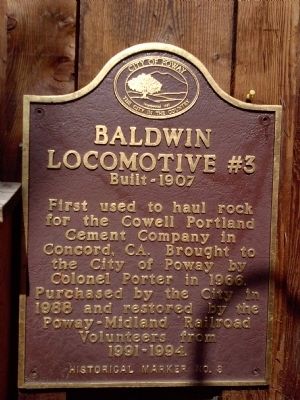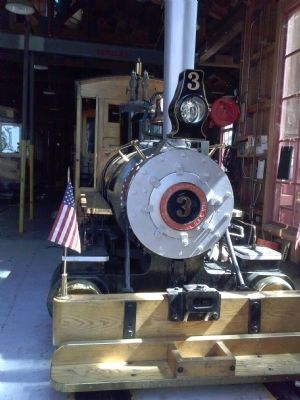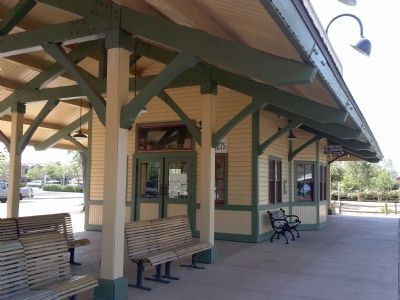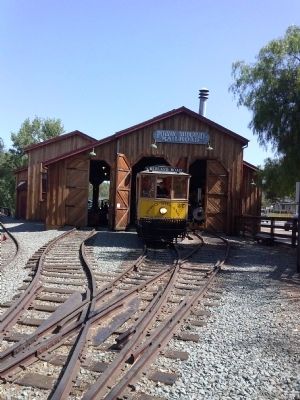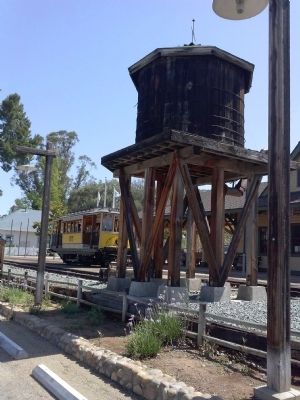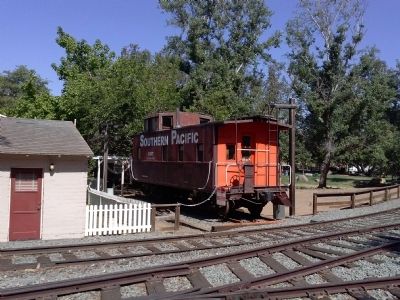Poway in San Diego County, California — The American West (Pacific Coastal)
Baldwin Locomotive No. 3
Built - 1907
Erected by City of Poway. (Marker Number 8.)
Topics. This historical marker is listed in this topic list: Railroads & Streetcars. A significant historical year for this entry is 1966.
Location. 32° 58.255′ N, 117° 2.179′ W. Marker is in Poway, California, in San Diego County. Marker is on Midland Road, on the right when traveling south. The historic marker is on the Midland Road wall of the train barn. Touch for map. Marker is at or near this postal address: 14134 Midland Road, Poway CA 92074, United States of America. Touch for directions.
Other nearby markers. At least 8 other markers are within walking distance of this marker. Porter House (here, next to this marker); City of Poway Veterans Park (within shouting distance of this marker); Nelson House (about 300 feet away, measured in a direct line); Templars Hall (about 300 feet away); DJ Ranch Formerly: Kent Farm (approx. half a mile away); Dearborn Memorial Park (approx. 0.6 miles away); Flint Farm (approx. 0.7 miles away); Community Church of Poway (approx. 0.7 miles away). Touch for a list and map of all markers in Poway.
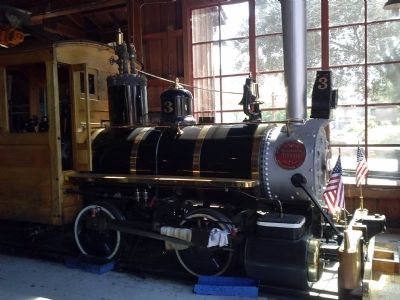
Photographed By Marsha A. Matson, May 24, 2014
2. Baldwin Locomotive No. 3
The centerpiece of the collection was built in 1907 by the Baldwin Locomotive Works in Philadelphia, PA for the Henry Cowell Lime and Cement Company of Cowell, CA. The locomotive, originally dubbed “Engine No. 3″, and its sister engines were used to haul rock from the company’s quarry to the crushing mill, a distance of three miles. In 1952, “No. 3″ was sold to the South San Francisco Scrap Metals Company, where it was used to move other pieces of railroad equipment around the scrap yard.
In 1960, Charles Pollard of Vista, CA, bought “No. 3″ and extensively modified its appearance to resemble much older steam engines of the 1870s. He operated the locomotive, then called the “Robert E. Lee,” on the grounds of his machine shop. When Pollard died in 1966, the locomotive and various other pieces of rolling stock and railroad equipment were purchased by John S. Porter of Poway. Porter built a small station, house and shed for the train and operated it on his land which today comprises part of our park. Mr. Porter died in 1980, ending the operation of his “Poway Village and Rattlesnake Creek Railroad.”
In December of 1987, the City of Poway purchased the Porter property – lock, stock and locomotive. The locomotive and its tender have been restored to full operational condition by the PMRRV. Restoration, certification and testing were completed early in 1997 and the locomotive made its inaugural PMRR passenger run on July 4, 1997.
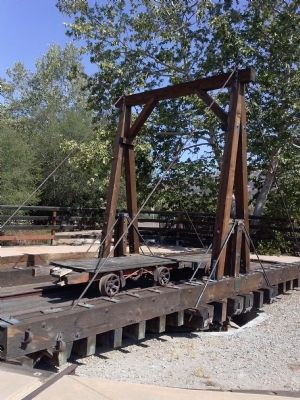
Photographed By Marsha A. Matson, May 24, 2014
4. Turntable
The gallows style turntable was built for the PMRR in 2002 and dedicated July 4 of that year. Although based on the design of the Laws, California, turntable, it is two-thirds the size at 35 feet long. This is one of only five Gallows turntables operating in California. Operated by hand, the turntable is used to reposition equipment from one track to another. It is also used to turn equipment 180 degrees for reverse running to equalize wear on the wheels and track.
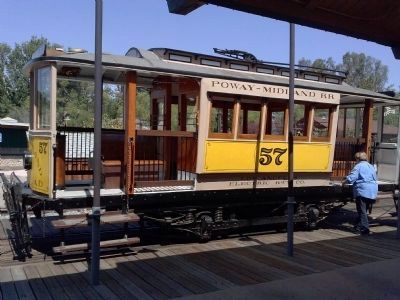
Photographed By Marsha A. Matson, May 24, 2014
7. 1894 Trolley
Built in 1894 (approximately), it was operated as part of the "Yellow Line" interurban trolley system of the Los Angeles Railway (LARY). Originally 20 feet long, it was configured as a simple "open bencher." In 1912, it was reworked in LARY's shops. Vestibules were added on each end, bringing its length to 30 feet. It was sold to a movie studio in 1923 where it was further modified to the combination of open bench and enclosed seating known as the "California Car" configuration. At some point in its history, the trolley's electric motors were replaced with a Corvair automobile engine, which is the current mode of power. The PMRRV purchased the trolley in the Spring of 1993 from a private party. Structural, mechanical and cosmetic restorations were made, and it has been operational since July, 1997.
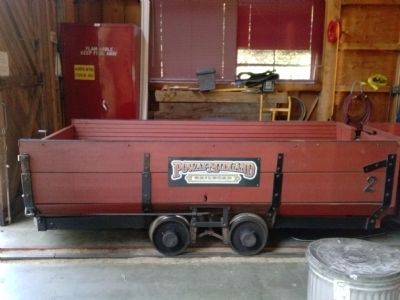
Photographed By Marsha A. Matson, May 24, 2014
8. Gondola Car
The four wood-sided gondola cars are used today for carrying passengers around the track behind the Fairmont speeder and behind the Locomotive. They were built in the 1880s for use in hauling a different cargo – rocks and ore from the mines. They are typical of the narrow gauge ore cars once used in mining operations throughout the West. Originally, the interiors of the cars were faced with sheet metal to prolong the useful life of the wooden planks forming the sides and ends. All of the wood was in such poor condition that it was replaced and seats were installed to carry passengers. Each car seats up to 12 passengers.
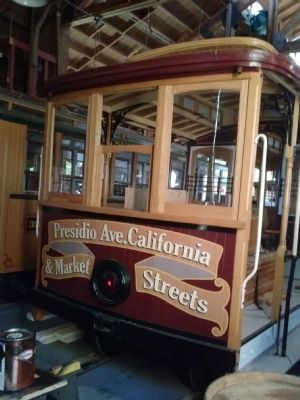
Photographed By Marsha A. Matson, May 24, 2014
11. 1906 San Francisco Cable Car
Car number 17of the California Street Cable Railway was built in 1906 to replace cars destroyed in the San Francisco earthquake. It was purchased by Knott's Berry Farm in 1956, repowered to run on batteries and used until 1988. It was then transferred to the City of San Diego for use in the Gaslamp Quarter. Because of incompatible track gauge, the car was never used. It was transferred to the City of Poway in October 1997. The car is in the process of being fully restored and added to the operating roster.
Credits. This page was last revised on June 16, 2016. It was originally submitted on May 31, 2014, by Marsha A. Matson of Palmetto Bay, Florida. This page has been viewed 811 times since then and 147 times this year. Photos: 1, 2, 3, 4, 5, 6, 7, 8, 9, 10, 11. submitted on May 31, 2014, by Marsha A. Matson of Palmetto Bay, Florida. • Bill Pfingsten was the editor who published this page.
